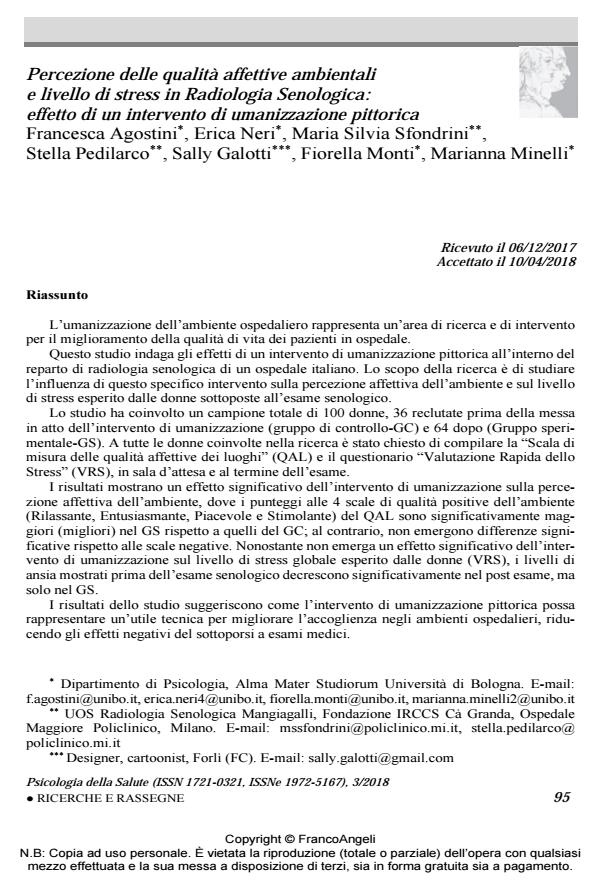Percezione delle qualità affettive ambientali e livello di stress in Radiologia Senologica: effetto di un intervento di umanizzazione pittorica
Titolo Rivista PSICOLOGIA DELLA SALUTE
Autori/Curatori Francesca Agostini, Erica Neri, Maria Silvia Sfondrini, Stella Pedilarco, Sally Galotti, Fiorella Monti, Marianna Minelli
Anno di pubblicazione 2018 Fascicolo 2018/3
Lingua Italiano Numero pagine 19 P. 95-113 Dimensione file 220 KB
DOI 10.3280/PDS2018-003005
Il DOI è il codice a barre della proprietà intellettuale: per saperne di più
clicca qui
Qui sotto puoi vedere in anteprima la prima pagina di questo articolo.
Se questo articolo ti interessa, lo puoi acquistare (e scaricare in formato pdf) seguendo le facili indicazioni per acquistare il download credit. Acquista Download Credits per scaricare questo Articolo in formato PDF

FrancoAngeli è membro della Publishers International Linking Association, Inc (PILA)associazione indipendente e non profit per facilitare (attraverso i servizi tecnologici implementati da CrossRef.org) l’accesso degli studiosi ai contenuti digitali nelle pubblicazioni professionali e scientifiche
L’umanizzazione dell’ambiente ospedaliero rappresenta un’area di ricerca e di intervento per il miglioramento della qualità di vita dei pazienti in ospedale. Questo studio indaga gli effetti di un intervento di umanizzazione pittorica all’interno del reparto di radiologia senologica di un ospedale italiano. Lo scopo della ricerca è di studiare l’influenza di questo specifico intervento sulla percezione affettiva dell’ambiente e sul livello di stress esperito dalle donne sottoposte all’esame senologico. Lo studio ha coinvolto un campione totale di 100 donne, 36 reclutate prima della messa in atto dell’intervento di umanizzazione (gruppo di controllo-GC) e 64 dopo (Gruppo speri-mentale-GS). A tutte le donne coinvolte nella ricerca è stato chiesto di compilare la "Scala di misura delle qualità affettive dei luoghi" (QAL) e il questionario "Valutazione Rapida dello Stress" (VRS), in sala d’attesa e al termine dell’esame. I risultati mostrano un effetto significativo dell’intervento di umanizzazione sulla perce-zione affettiva dell’ambiente, dove i punteggi alle 4 scale di qualità positive dell’ambiente (Rilassante, Entusiasmante, Piacevole e Stimolante) del QAL sono significativamente maggiori (migliori) nel GS rispetto a quelli del GC; al contrario, non emergono differenze significative rispetto alle scale negative. Nonostante non emerga un effetto significativo dell’intervento di umanizzazione sul livello di stress globale esperito dalle donne (VRS), i livelli di ansia mostrati prima dell’esame senologico decrescono significativamente nel post esame, ma solo nel GS. I risultati dello studio suggeriscono come l’intervento di umanizzazione pittorica possa rappresentare un’utile tecnica per migliorare l’accoglienza negli ambienti ospedalieri, riducendo gli effetti negativi del sottoporsi a esami medici.
Parole chiave:Umanizzazione pittorica, ambiente ospedaliero, qualità affettiva ambientale, stress, Radiologia Senologica.
- Parental Distress and Affective Perception of Hospital Environment after a Pictorial Intervention in a Neonatal Intensive Care Unit Erica Neri, Federica Genova, Marcello Stella, Alessandra Provera, Augusto Biasini, Francesca Agostini, in International Journal of Environmental Research and Public Health /2022 pp.8893
DOI: 10.3390/ijerph19158893 - Parents' and nurses' affective perception of a pictorial intervention in a pediatric hospital environment: Quasi-experimental design pre-post-testing Lea Godino, Elisa La Malfa, Mattia Ricco, Stefano Mancin, Elisa Ambrosi, Manuela De Rosa, Barbara Martelli, Virginia Lepore, Latifa El Mouttaqi, Sergio Cinocca, Marcello Lanari, Domenica Gazineo, in Journal of Pediatric Nursing /2024 pp.89
DOI: 10.1016/j.pedn.2024.03.021
Francesca Agostini, Erica Neri, Maria Silvia Sfondrini, Stella Pedilarco, Sally Galotti, Fiorella Monti, Marianna Minelli, Percezione delle qualità affettive ambientali e livello di stress in Radiologia Senologica: effetto di un intervento di umanizzazione pittorica in "PSICOLOGIA DELLA SALUTE" 3/2018, pp 95-113, DOI: 10.3280/PDS2018-003005